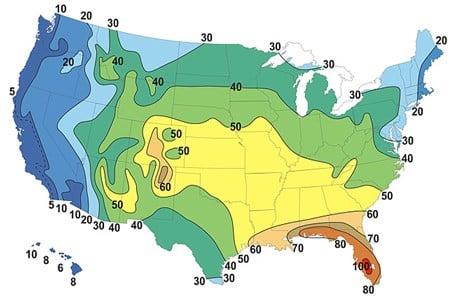Thunderstorms
Of the estimated 100,000 thunderstorms that occur each year in the United States, about 10% are classified as severe. The National Weather Service considers a thunderstorm severe if it produces hail the size of a U.S. quarter or larger or winds of 58 mph or stronger. Severe thunderstorms are known to cause significant damage to well-built structures or cause bodily harm. These strong storms can also produce frequent and dangerous lightning, flooding and tornadoes.
On average, the interior sections of central Florida receive the most thunderstorms with nearly 100 plus days per year. However, thunderstorms are also frequent along coastal areas which average 80 to 90 days per year.

In the United States, there are an estimated 25 million lightning flashes each year. In an average year, Florida sees around 1.4 million of these lightning strikes. This makes Florida the "Lightning Capital of the United States." Lightning occurs with every thunderstorm. Because of Florida's vulnerability to thunderstorms and lightning, lightning is one of the most deadly weather hazards in the Sunshine State.
In order to tell how close a lightning strike is, count the seconds between the lightning flash and the resulting thunder. For every five seconds you count, lightning is one mile away. A good rule of thumb with regards to lightning safety is to remember that if you can hear thunder, you are close enough to be struck by lightning. Even if it is not raining where you are, lightning can still reach you. Lightning can travel as far as 10 miles away from its thunderstorm, and has been observed as far as 25 miles away. This is why the best thing you can do when you see lightning is seek safe shelter as soon as possible.
Severe Thunderstorm Watch - Issued by the Storm Prediction Center to alert the public that conditions are favorable for the development of severe thunderstorms in and close to the watch area. These watches are issued with information concerning the watch area and the length of time they are in effect. During the watch, people should review severe thunderstorm safety rules and be prepared to move a place of safety if threatening weather approaches.
Severe Thunderstorm Warning - Issued by local National Weather Service offices to warn the public that a severe thunderstorm has been sighted by storm spotters or has been indicated by radar. People in the affected area should seek safe shelter immediately.
- Have a NOAA All-Hazards Weather Radio and battery backup to receive important weather and other emergency-related warnings.
- Discuss thunderstorm safety with all members of your household or business. Locate or build a Safe Room in the interior of your home or business.
- Check the weather forecast before leaving for extended periods outdoors and watch for signs of approaching storms while outside. Postpone outdoor activities if storms are imminent.
- Inquire if your Community is StormReady.

